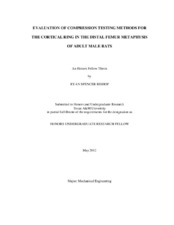| dc.description.abstract | The characterization of bone loss in astronauts continues to be a pressing health concern for astronauts who spend months aboard the International Space Station (ISS). Through the use of the hindlimb unloaded rat model, Hogan et. al. have compared the effect of unloading at different anatomical bone sites and compartments within the hindlimb bones.(1) Because femur metaphysis bone specimens remain from a previous experiment that tested the cancellous compartment, the untested cortical rings remain to be characterized. However, due to the complex geometry and composition of the cortical bone, an appropriate testing method must be identified which will effectively evaluate the effect of hindlimb unloading on this bone tissue. This study compared the use of axial and diametral compression testing in evaluating the intrinsic properties, namely, ultimate stress and elastic modulus, of the cortical ring of the femur metaphysis. In order to preserve the cortical specimens from the hindlimb unloaded study, practice bones (taken from rats not used or removed from the study) were tested. After approximating the cortical geometry of each specimen, the bones were divided into axial and diametral compression testing groups (n=3), and the bones were compressed to failure.
Diametral testing was found to result in a much more consistent location of failure than the axial testing, but the standard deviations for the calculated ultimate stress and elastic modulus were considerably higher. Both the diametral and axial testing yielded properties that deviated significantly from those previously calculated for femoral diaphysis samples. This deviation is unsurprising, as the lack of recorded background and the dimensional approximations used to analyze the bones likely introduced errors that compromised accurate determination of absolute values. However, the results remain useful for comparison purposes. With more accurate measurement of cortical geometry and the use of the more consistently cut metaphysis samples from known testing conditions, both testing methods may yield properties closer to those found for the femoral diaphysis. Although the axial compression testing displayed more variation in the location of failure, this method is currently recommended because the calculated ultimate stress and elastic modulus values displayed significantly reduced variance. | en |



